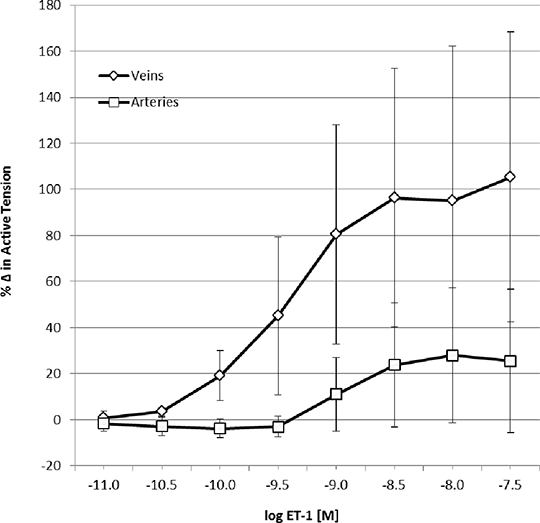Print version
Search Pub Med
Efficacy and Potency of Endothelin-1 (ET-1) in Isolated Human Pulmonary Arteries and Veins Background Extensive research has realised the clinical benefits of endothelin antagonists in the treatment of pulmonary arterial hypertension of various aetiologies. A number of in vitro animal studies (1-3) have shown that ET-1 is a more potent and more efficacious constrictor in the pulmonary veins than the pulmonary arteries which suggest that the contractile effects of ET-1 on the pulmonary veins is of more pathophysiological significance than the effect of ET-1 on the pulmonary arteries. The purpose of this study was to compare the potency and efficacy of ET-1 in human pulmonary arteries and veins. Methods Rings of human pulmonary arteries and veins were obtained at resection for cancer and mounted between stainless steel wires in 25 ml organ baths to measure changes in isometric tension. Concentration response curves were constructed to ET-1 by cumulative addition to the organ baths. Results ET-1 was a significantly more potent vasoconstrictor in human pulmonary veins (n=9) than in human pulmonary arteries (n=9) (pEC50 9.36 ± 0.26 vs. 8.71 ± 0.38 for veins and arteries respectively, mean ± SD, p = < .01 via 2-tail, unpaired t-test for parametric data with unequal variance). The efficacy of ET-1 was also greater in the pulmonary veins compared to the pulmonary arteries, which was statistically significant at most concentrations tested. (Figure 1). Figure 1. Log concentration response curve to ET-1 in isolated human pulmonary arteries (n = 9) and veins (n = 9). Effect of ET-1 is shown as % change in baseline tension. ** p < .01, * p < .05 arteries vs. veins via 2-tail, unpaired t-test for parametric data with unequal variance. Error bars are SD.
(1) Aharinejad S et al. (1995). J Thorac Cardiovasc Surg 110: 148-56. (2) Kemp BK et al. (1997). Br J Pharmacol 121: 441-50. (3) Toga H et al. (1992). Am.J.Physiol.Lung Cell.Mol.Physiol 263: L15-21.
|


